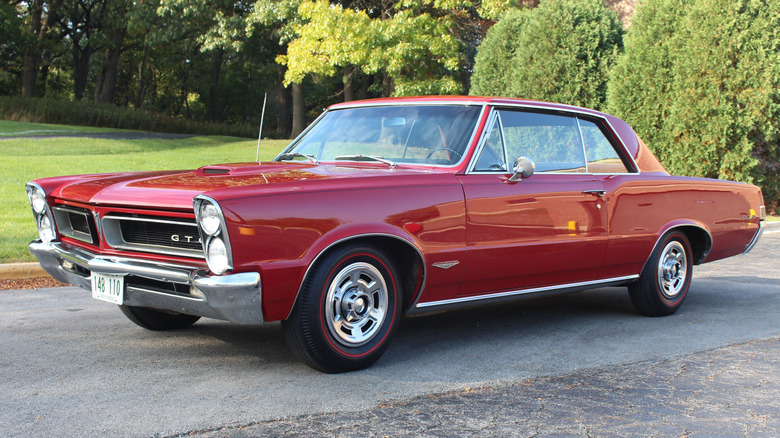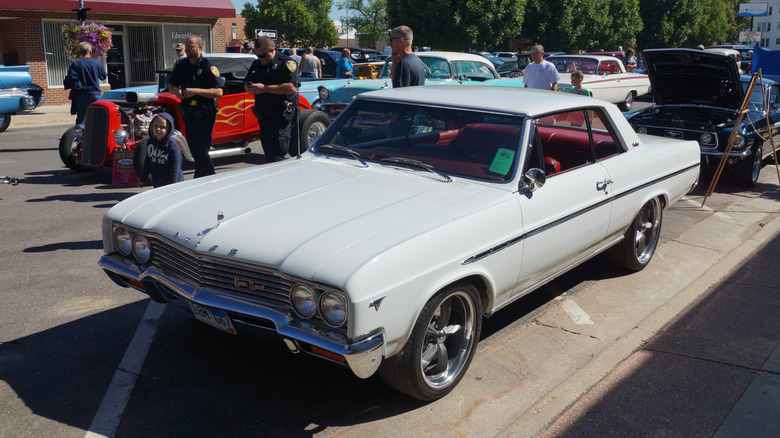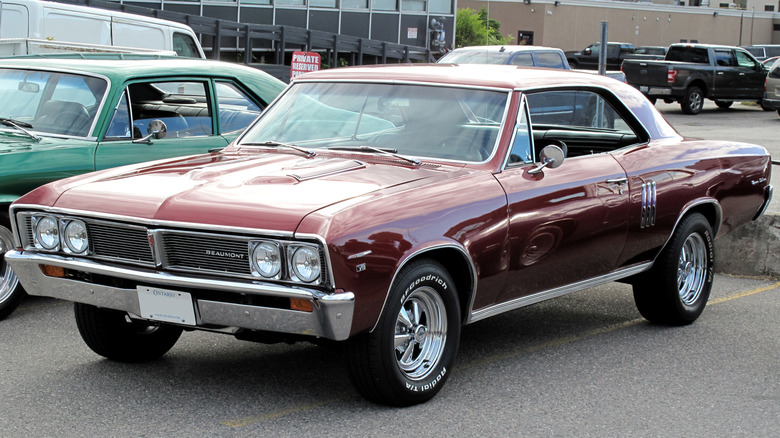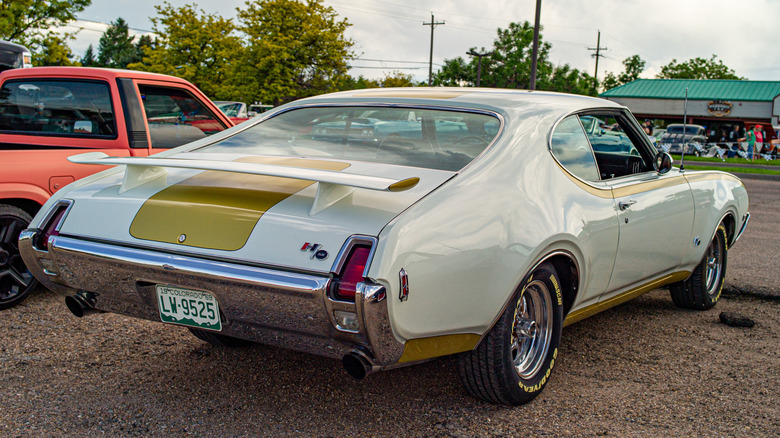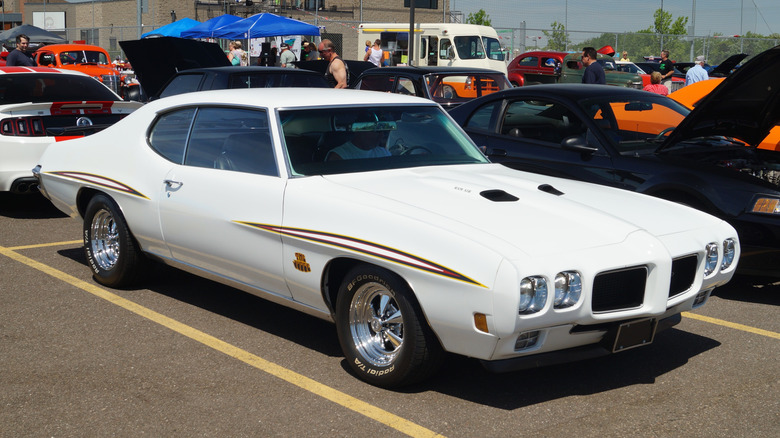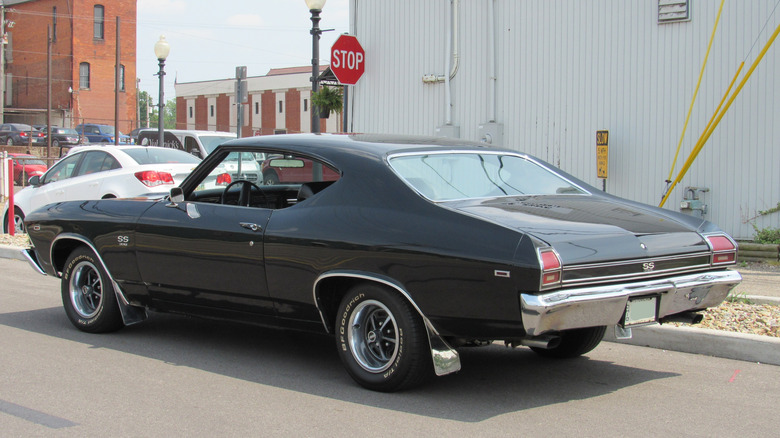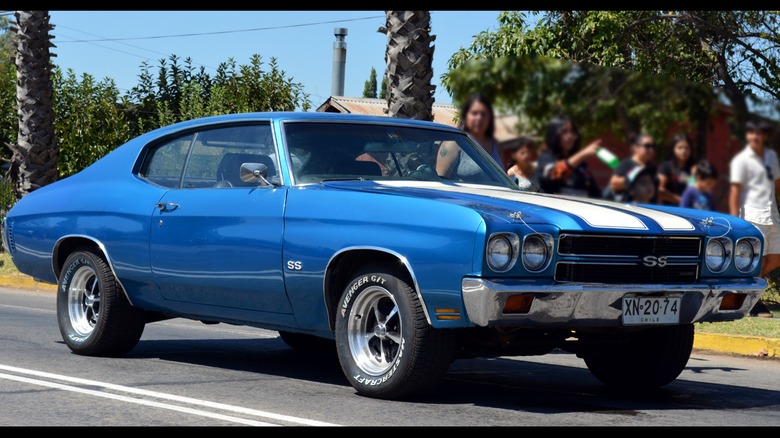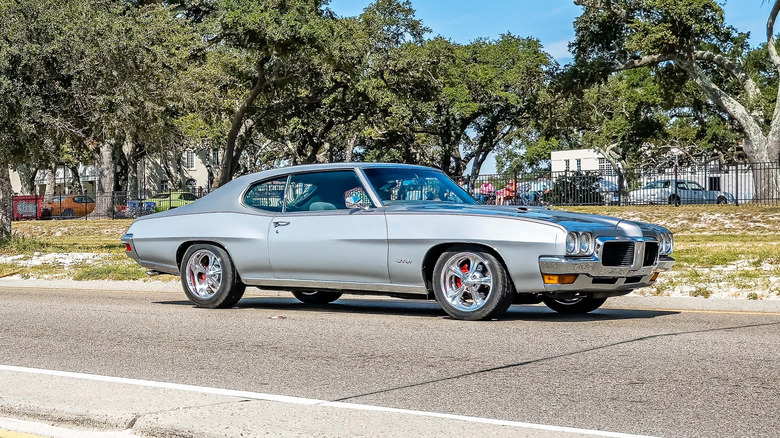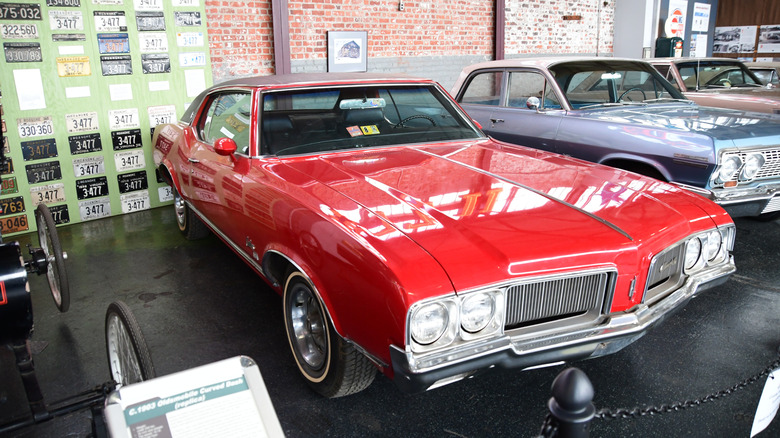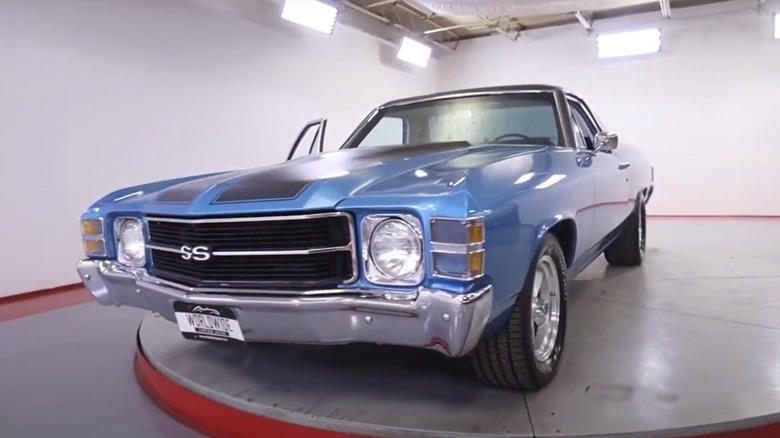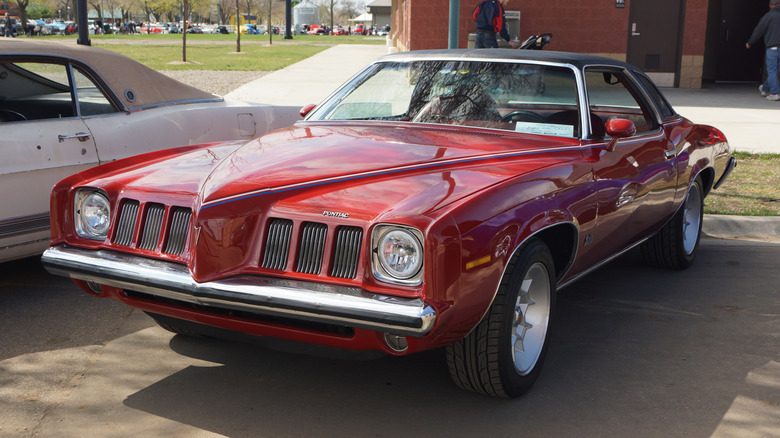10 A-Body GM Muscle Cars That Are Worth Remembering
GM's intermediate-sized A-body platform formed the basis for some of the most well-loved models of the 1960s and 1970s, including some of the classics of the muscle car era. Its legendary run lasted for decades until it was replaced with the G-body platform in the 1980s, and the A-body designation was reassigned to a new front-wheel drive platform. In its classic rear-wheel drive form introduced in 1964, the A-body chassis featured a 115-inch wheelbase and a perimeter frame that replaced the unibody structure of its Y-body predecessor. The roofline, glass, some suspension components, and inner structure would be shared between divisions, but everything else would be unique to each brand.
In its first year, Pontiac would transform the A-body-based Pontiac LeMans into the GTO, beloved by many as the world's first true muscle car. Oldsmobile, Buick, Chevy, and GM Canada's Acadian division would also build iconic special edition vehicles on this platform. GM limited A-bodies to 330-cubic-inch engines in 1964, but in 1965 it increased the limit to 400 cubic inches. This gave rise to some of the most intense high-performance muscle cars of all time, especially since, as we'll see, the divisions sometimes found ways to get around even that stratospheric displacement limit. In 1968, the A-body cars were redesigned with curvier sheet metal and lust-worthy proportions, with classic long-nosed, short-deck dimensions.
What follows are 10 A-body muscle cars worthy of remembrance. Some of the vehicles below are special editions of already iconic cars like the GTO. Others are less well-known models that display their engineers' cleverness at packing high performance into affordable packages. Any one of these dream machines could be the star of a classic car collection today.
1965 Buick Skylark Gran Sport
The Buick GS series isn't as famous as the Pontiac GTO or Olds 4-4-2, but it's still a well-known and well-respected member of the A-body muscle car family. However, the GS started out as the 1965 Skylark Gran Sport, a model often overlooked by collectors today. The Skylark name had graced other models in the 1950s and early 1960s. In 1964, it became Buick's variant of the A-body platform, an up-market alternative to its Chevy Chevelle and Pontiac Tempest cousins. Its styling was stately and attractive, but in its initial model year, it didn't have a muscle car variant.
That changed in 1965 with the introduction of the Skylark Gran Sport, Buick's attempt to capture some of the performance cachet of the Pontiac GTO. Buick dropped its 400-cubic-inch V8 into the Skylark's engine bay, giving it 325 horsepower and a tire-smoking 445 lb-ft of torque. The engine actually displaced 401 cubic inches, but Buick labeled it 400 to get around GM's prohibition on engines larger than 400 cubic inches. This powerplant featured four-barrel carburetors, hydraulic lifters, and a 10.25:1 compression ratio. It had previously appeared in the Electra 225 and Wildcat models. Two manual transmissions and the Super Turbine 300 automatic were offered.
Road tests at the time produced 0 to 60 mph times under eight seconds and a quarter-mile time of about 16.6 seconds. This wasn't blistering performance compared to later muscle cars, including the Gran Sport's GS and GSX descendants, but this car came out very early in the muscle car era. This makes it an excellent value for collectors seeking stately looks and decent performance at a relative bargain.
1964 to 1969 Beaumont
GM has a long history in Canada dating back to when the McLaughlin Motor Car Company became GM Canada in 1918. During much of that time, Ottawa's tariffs on foreign-built cars led GM to assemble most of its Canadian-market cars in that country, leading the company to create some Canadian GM brands never sold in the USA. One of these was Acadian, launched in 1962 initially to sell Pontiac-like bodies with Chevy running gear and unique grilles. Acadian's first cars were built on the Chevy II platform, but in 1964, an A-body-based model called the Beaumont joined the lineup. Two years later, the Beaumont was spun off into its own brand.
At a glance, the Beaumont could easily be mistaken for the Chevelle on which it was based. Only its split grille and some minor trim pieces distinguished it from its Chevy half-sibling from south of the 49th parallel. The Beaumont came with a range of engines, but the rarest and most powerful was the L79, a 327-cubic-inch, 350-horsepower V8, which Acadian matched with a Muncie four-speed manual. In the States, this motor was found in some Chevy II, Chevelle Malibu, and Corvette models.
Only 23 Beaumonts were built with the L79 in 1965, giving an idea of how rare this high-powered muscle car was. In that same year, Canada and the U.S. signed the Automotive Product Trade Agreement, eliminating tariffs along with the Acadian and Beaumont brands' reason for existing. Acadian would soldier on into the 1970s, but by 1969, the Beaumont name faded into history.
1968 Hurst/Oldsmobile
The Hurst name was associated with Oldsmobiles for decades, but it all began in 1968 with the first Hurst/Oldsmobile. GM prohibited its divisions from installing engines of greater than 400 cubic inches in its A-body cars, but George Hurst found a way around the rule. Hurst was a business owner and inventor who made the shifters that bore his name and also invented the Jaws of Life. By upgrading Oldsmobile 4-4-2 models at his own factory, he could circumvent GM's engine displacement limit to build an old-school Oldsmobile worthy of attention.
The resulting Hurst/Oldsmobile was a high-output brute with a modified 455-cubic-inch V8 with an Outside Air Induction system, custom distributor and carburetor, and rare "D" casting cylinder heads. Its Turbo Hydra-Matic automatic transmission could be shifted like a manual gearbox. The car also featured upgraded brakes and a heavy-duty suspension. The first Hurst/Olds cars received custom silver and black paint jobs before transitioning to the white and gold color scheme that would characterize most subsequent cars in the series.
The Hurst/Olds also offered comfort and luxury befitting Oldsmobile's upscale market position. The interior featured black vinyl bucket seats, a walnut insert around the shifter, and a wood-grain steering wheel. A real walnut insert and pinstripes ran the length of the dashboard. A power seat and power windows were optional. The buyer had a choice of radios, although the music was probably frequently drowned out by the squeal of smoking tires.
1969 Pontiac GTO Judge
The original 1964 Pontiac GTO is considered by many to have been the Big Bang of the muscle car era, the point where it all began. By 1969, however, competitors were rolling into its performance territory. And this leads to the story of how a Pontiac GTO gained the nickname "The Judge." This car was Pontiac's response to the competition, particularly the Plymouth Road Runner, named after the popular Looney Tunes character. The Road Runner was a bargain-priced muscle car that threatened to steal sales away from the more expensive GTO.
John DeLorean, Pontiac's general manager, who would later build one of the most controversial cars ever made, formed a group within Pontiac to build a Road Runner-beater. To keep costs down, the group used the Pontiac 350 engine but equipped it with performance parts, including the heads from a 400 V8 and a Quadrajet four-barrel carb. Some expensive exterior GTO parts were swapped out for pieces from the standard LeMans, including the LeMans' hood and chrome bumper. Steel wheels and a bench seat completed the downscaling.
Yet after DeLorean saw the results, he insisted that the car needed to be redone as a real GTO. The cheaper bits were swapped back out for the GTO's bucket seats, its scooped hood, and its body-colored bumpers, and buyers would get a choice of either the 366-horsepower Ram Air III or the 370-horsepower Ram Air IV. The car gained the nickname "The Judge" from Sammy Davis Jr.'s character on "Rowan and Martin's Laugh-In." Oh, and unlike Wile E. Coyote, the Judge proved capable of catching the Road Runner.
1969 Chevy Chevelle COPO L72
The 1969 Chevelle COPO was another GM muscle car born out of a desire to get around GM's 400-cubic-inch limit. The result was one of the coolest muscle cars of 1969, and one of the rarest of all time. COPO stands for Central Office Production Order, and this group within Chevy originally had a much more pedestrian function than building in-your-face performance cars: It added heavy-duty components to commercial vehicles like taxis and rental cars. A Chevy dealer named Fred Gibb thought COPO could be used to get around GM's displacement limit.
Gibb ordered several dozen 1969 Camaros with 427-cubic-inch engines through the COPO program. Once he proved the idea would work, Chevy dealers began ordering multiple models with COPO performance upgrades, including the Chevelle. The Chevelle COPO L72 was equipped with a 427-cubic-inch, 425-horsepower V8 with 460 lb-ft of torque. To handle the extra power, transmissions included the four-speed Rock Crusher manual and a fortified M40 Turbo Hydra-Matic automatic. An upgraded rear axle assembly featuring a beefed-up differential with optional Positraction helped to channel the L72's fury to the ground without losing control.
Ventilated front disk brakes, heavy-duty suspension bits, a three-core radiator, and dual exhaust provide only a partial list of the car's many upgrades. On the outside and in the interior, everything was stock Chevelle Malibu, turning the Chevelle COPO into one of the greatest sleepers in muscle car history. Observers would have no way to know it could hit 60 in 5 seconds and run the quarter mile in 13.3 seconds. Fred Gibb's idea proved to be ingenious.
1970 to 1972 Chevy Chevelle SS 454
In 1970, GM lifted the 400-cubic-inch limit, and its divisions were free to unleash as much power as its engineers could dream up, with no need to resort to gray-market workarounds like the Hurst/Olds and Chevelle COPO. Chevy took the lead with the bonkers Chevelle SS 454, which delivered between 360 and 450 horsepower. Outdoing many classic muscle car engines with tons of torque, the SS 454 cranked out an earth-moving 500 lb-ft of force. This Chevelle took full advantage of the lack of displacement limits.
Choosing the LS5 454-cubic-inch engine would get a buyer 360 horsepower. This version featured cast iron heads, hydraulic valve lifters, and a four-barrel Rochester carburetor. Upgrading to the LS6 unleashed the full 450 horsepower via unique heads, solid valve lifters, a beefed-up camshaft, and one of two four-barrel Holley carbs. A heavy-duty suspension and power front disc brakes helped keep all this power under control, while exterior cues included chrome-tipped dual exhausts, SS wheels framed by wheel arch moldings, and additional special trim pieces like a black grille. The Cowl-Induction hood package channeled cold air to the carburetor.
The LS6 1970 Chevelle SS 454 could run to 60 mph in just a shade over six seconds and breach the quarter-mile mark in only 13.44 seconds. Unfortunately, that was the absolute crest of the muscle-car wave. In 1971, GM lowered compression ratios so that engines would run better on low-lead fuel. Chevy also switched from gross to net horsepower ratings in 1971 to prepare to meet California regulations, which made the reduced horsepower numbers look even lower. The Golden Age of muscle cars was drawing to a close.
1970 to 1971 Pontiac GT-37
While some A-body models have become legends, some of GM's brands also offered stripped-down muscle cars for customers on a budget. These cars may not get the glory, but they deserve to be remembered. They were built partly as a reaction to the bargain-priced Plymouth Road Runner introduced in 1968, which became an unexpected hit and stole some of GM's performance thunder. Pontiac's response was two-fold. Part of the way through the 1970 model year, it offered a stripped-down model called the Tempest T-37, and then it based an affordable muscle car on it, which it called the GT-37.
The GT-37's standard motor was a 350-cubic-inch engine with a two-barrel carburetor. This unit produced a comparatively modest 255 horsepower. However, buyers could opt for a 400-cubic-inch, 330-horsepower V8. The exterior of all GT-37s also got an upgrade, with hood locking pins, GTO Judge-style stripes, Rally II wheels, a dual exhaust, and GT-37 decals. A Hurst Floor Shifter completed the package. In 1971, a pair of 455-cubic-inch V8s was offered.
With a 400 or 455 V8, the GT-37 was a legitimate muscle car. Yet it never achieved the fame of the GTO Judge and sold in low numbers. While almost 6,000 were built with the 350 engine, fewer than 800 total featured a 400 or 455. Given its rarity, you might expect the GT-37 to be highly sought after. Yet for many years, collectors nearly forgot the Pontiac GT-37, despite how much horsepower it produced at a price most people could afford.
1970 to 1971 Oldsmobile Cutlass Supreme SX
By 1970, insuring a $4,000 muscle car could cost as much as $1,500 per year, according to the CarInsuranceQuotes website. This became a real problem for would-be buyers of high-powered Detroit iron. To help its customers and fool the insurance companies, Oldsmobile slipped a 455-cubic-inch V8 into a Cutlass Supreme without giving it a 4-4-2 VIN. The result was the Cutlass Supreme SX, a genuine muscle car disguised as a personal luxury coupe. Olds offered it for 1970 and 1971.
The Cutlass Supreme SX featured Oldsmobile's upscale-looking take on the A-body platform with very few hints at the power beneath the hood. Chromed dual exhaust tips and subtle SX badges were the only giveaways; The car was stripped of hood scoops, stripes, and other trim features that normally came with the monster 455 V8 in the 4-4-2. The interiors were befitting of luxury cars, with plush seating, AC, and power everything.
The Cutlass Supreme SX came with one transmission, the Turbo Hydra-Matic 400. Fender braces helped the SX's body to handle the engine's huge torque, which measured 500 lb-ft. These fender braces are also a good way for collectors to identify authentic SX models. This is important because the Olds snuck past classic car buyers like it did insurance companies, but the Cutlass Supreme SX is finally getting some recognition in the vintage muscle car market.
1971 to 1972 GMC Sprint SP
While many enthusiasts are familiar with the 1960s and 1970s El Camino, GMC's version was the Sprint, which was sold in smaller numbers and consequently is less well-known. Technically classified as a pickup truck, the Sprint nevertheless rode an A-body platform, and with a 454 big-block V8 stuffed under the hood, it was a legitimate muscle car. This version of the GMC's car-truck was called the Sprint SP, and it deserves a spot in enthusiasts' memories.
Introduced in 1971, GMC's badge-engineered clone of the El Camino received the LS5 454-cubic-inch V8. This engine featured a cast-iron block and cylinder heads, along with a Rochester Quadrajet four-barrel carb. Ads initially promised 390 horsepower, but the Sprint SP's engine received the same lower compression as other GM A-body cars in 1971, so by the time it hit the market, it sported 365 horsepower, or 285 under the new net horsepower ratings. In 1972, the number dropped further to 270 net horsepower. The Turbo Hydra-Matic 400 automatic transmission came standard with the 454.
1973 to 1975 Pontiac Grand Am
Horsepower lowered in the 1970s for a variety of reasons, including some we've already examined, like lower-compression engines and the switch from gross to net horsepower. By 1973, many enthusiasts would say the era had already come to an end. However, GM's A-body continued to underpin some models that were still muscle cars by the standards of this new era. The 1973 Pontiac Grand Am is arguably one of the best examples.
The A-body lineup across GM had been radically restyled for 1973, giving birth to the new colonnade cars. This was still a midsize, perimeter-frame platform, but there were no more two-pillar hardtops. The word colonnade refers to the fact that these A-bodies now had three pillars, including a B-pillar behind the door, which helped meet new federal rollover protection rules. They had long hoods and short decks and looked quite stylish for the time.
The 1973 Pontiac Grand Am version of the platform was offered with either a 400 or 455-cubic-inch V8. The latter offered 250 horsepower, good for a 7.9-second 0 to 60 mph run and a 15.7-second quarter-mile time. These numbers would barely have registered at the height of the horsepower wars, but for 1973, they were decent. Combined with the Grand Am's flashy looks, with a bulging hood leading to a pointed prow, an upward-sweeping character line behind the front wheel wells, curving haunches, and a louvered rear quarter window, the car stood out in a crowd. Unfortunately, it had abysmal gas mileage, and the shock of the oil embargo led to a sharp drop in sales in 1974 and 1975, after which Pontiac canceled it. The last flames of the muscle car era were extinguished.
